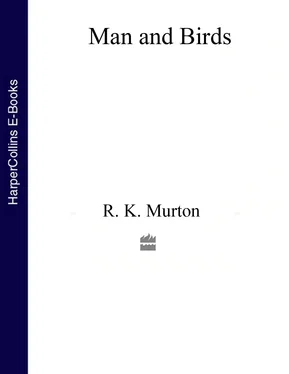With the outbreak of the First World War a new and widespread appreciation of birds was apparent. Birds were still used, but in an atmosphere of greater affection and regard. Canaries are about fifteen times more sensitive to poisonous gases than man, and they were accordingly kept in cages in the trenches to give advance warning of a gas attack, just as coal miners had used them in the mines. Soldiers enjoyed their companionship, and singing birds also were extensively used in ambulance trains. As pigeons had relayed the conquest of Gaul to Rome and had brought the first news of Napoleon’s defeat at Waterloo to England, so they were put to extensive use in the war, old converted London buses being used as mobile pigeon lofts. In the Second World War, pigeons were again used extensively; for example, the underground movement in France employed them to send back messages to England. German gunners tried to shoot these birds down as they crossed the Brittany cliffs, and in Britain the authorities attempted to exterminate our south coast peregrines, for fear that they too might be successful in intercepting some vital message. The following appeared in The Times on 19 August, 1943:
A pigeon, released by a bomber crew from their rubber dinghy, has recently been responsible for their rescue in the Mediterranean. … Realizing that something had gone wrong when there was no response to their first S.O.S., they had released their carrier pigeon from its container. As soon as the message it carried had been deciphered, an air-sea rescue launch put out, and the airmen were safely rescued.
In contrast with a report for 26 September, 1969:
‘In what was called “the craziest strike of all”, 44 men went on strike for half a day at the giant pressed steel Fisher Body plant in Swindon because of low-flying pigeons. The dispute was the latest of a series of labour stoppages which is costing Britain’s car industry the loss of millions of pounds in exports. The workers who walked out were those who were caught in the crossfire of the “feeders”, men who have been scattering bread crumbs and other bits of food to encourage the pigeons, and the “whangers”, other workers who have been throwing nuts and bolts and other missiles to scare the birds away. “We were fed up with either being hit by nuts and bolts aimed by the whangers, or strafed by the pigeons diving for food,” a press operator said. Meanwhile, a works management committee has asked the “whangers” to stop throwing missiles and the “feeders” to eat their sandwiches themselves.’
Some of the major developments in the relationships between men and birds since these years have been very briefly mentioned in the preface, but much more could be added for which there is no space. It would be pertinent to follow the growth of pet-keeping and other manifestations of an increasing public interest in living things. Similarly, we might examine the post-war boom in bird watching and the significance of such discoveries as the number of rare birds visiting sewage farms; the stampede to such sites was like an ornithological ‘gold rush’ once the initial discoveries at Nottingham were disclosed (Staton 1943). Has this widespread interest in wild life come too late?
The main hazards to birds today arise from the increasing pollution of the environment with the waste resulting from the sheer numbers of man; ironically man has become an indirect threat to the survival of wild life just when he seems to have learned to appreciate it. Mellanby has recently dealt with the pollution problem so admirably that I shall not attempt more than a passing reference here. But this should not detract from the severity of problems about which new facts emerge almost daily. For instance, we are still treading extremely cautiously so far as certain persistent agricultural chemicals are concerned. When the threat to wild life from organochlorine insecticides became really apparent in 1960–1, there was all manner of special pleading; agriculturalists claimed that food production must be the over-riding concern, manufacturers of chemicals naturally enough belittled the hazards to birds, bird protectionists made exaggerated claims, and Rachel Carson did the public at large a service with her deliberately biased book. In the years that have followed the initial hysteria, good sense has prevailed. Research has got under way and is producing facts where before there was only conjecture. When bird watchers first pointed out that birds of prey were breaking and eating their eggs and that this seemed to be associated with the decline in numbers associated with toxic chemicals, their suggestion was greeted with scepticism by many people. Now, a careful study by Ratcliffe has suggested some answers, for he has demonstrated that there has been a decline in egg-shell thickness in the peregrine, sparrowhawk and golden eagle since about 1950, and this explains why eggs are broken more readily and are subsequently eaten by the parent birds. Thus, of 109 peregrine eyries examined between 1904–50 there were only three instances of egg breakage, compared with 47 in 168 eyries observed between 1951–66. Egg-breakage, decrease in egg-shell weight, status of the breeding population and exposure to persistent pesticides are correlated, and it would be unreasonable to suppose that there is no causal connection, even if the exact factors and mechanisms involved remain to be elucidated. Calcium metabolism in birds is controlled by oestrogen and parathyroid hormone, and there is evidence that pp D.D.T. will interfere with oestrogen-based mechanisms in the Bengalese finch (Jefferies 1967).
Pollution of the environment by persistent, poisonous chemicals, is the most obvious problem, firstly because small residues can be accumulated in food chains, to give lethal dosages to the top predators, and secondly because they may produce unsuspected side-effects. But pollution by detergents, oil, smoke and other waste from man also present grave problems. Oil spillage at sea, either accidental or resulting from the purposeful jettisoning, is a serious hazard to seabirds against which the International Committee for Bird Preservation and other bodies have long campaigned, to a large extent successfully in the sense that the problem is recognised internationally. Bourne (1968), in a valuable review of the subject, mentions that as long ago as 1907 the largest seven-masted schooner built, the Thomas W. Lawson , was wrecked on the Isles of Scilly on her maiden voyage. The release of her entire cargo of ‘two million gallons’ of crude oil caused a vast slaughter of local seabirds, particularly puffins. In those days Annet is supposed to have supported about 100,000 puffins, whereas to-day only about 100 remain. All the colonies in the Western Approaches have been similarly reduced (as Parslow 1967 has shown) and it seems likely that oil pollution has been a major cause.
The loss at sea of oil-carrying vessels during the 1914–18 war resulted in a large increase in the numbers of oiled seabirds. This led the Royal Society for the Protection of Birds to publish figures in 1921 which played a large part in the introduction of the ‘Oil in Navigable Waters Act’ soon after. In the Second World War most tankers carried petroleum spirits, and the destruction of shipping presented less hazard. But this situation has changed as the needs of a modern industrialised world have led to an enormous expansion in oil traffic at sea; nowadays crude oil is carried to refinement plants near the destination in giant tankers. Constant pollution arises from ships washing-out at sea after a voyage and purposely releasing oil, while occasional accidents can have widescale repercussions. Thus, during the night of 18 September, 1966, the German tanker Seestern allowed 1,700 tons of crude diesel oil to escape into the Medway Estuary on a flood tide, polluting 8,000 acres of saltings. Probably about 5,000 birds died immediately. Certainly, 936 black-headed gulls, 927 great black-backed gulls, 184 dunlin, 165 herring gulls, 135 redshank, 98 common gulls, 90 oystercatchers, 65 curlew and various other birds (including an American pectoral sandpiper) were picked up. In this case the number of birds using the area had declined, by 20–100% depending on the species, in the following winter, but has since recovered so possibly no permanent damage has been done, yet for years an area could be denuded of suitable plant and animal food for birds and other wildlife. Only a small oil slick of about 87 tons hit the Tay estuary, the most important wintering ground for eiders, in March 1968. Fortunately, most of the birds had left, but between 7–26% of the national eider population was wiped out: the happy state of affairs pertaining to eiders and described above could soon be reversed. These modern incidents compare with R.S.P.B. estimates made for the 1940s and 50s that between 50,000–250,000 birds were being killed per year in home waters.
Читать дальше












